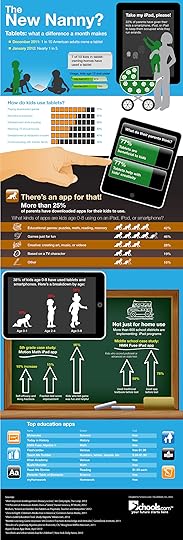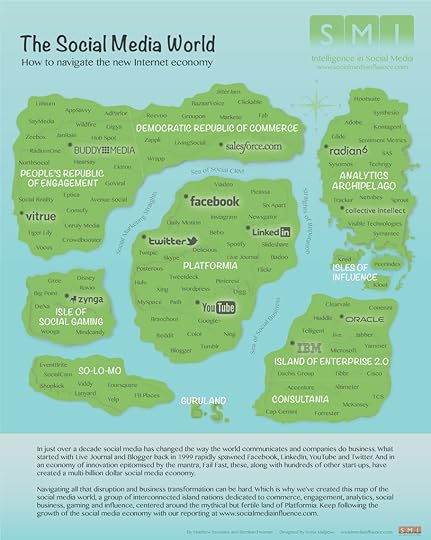Erik Qualman's Blog, page 662
June 14, 2012
iPads for Kids Infograph

Are iPads good or bad for kids? How prevalent are they? The following inforaphic attempts to answer these questions.
Does anyone know how early one can give a child an iPad before causing more harm than good? I’ve heard 3 from a respected psychologist, but haven’t been able to confirm.
[image error]
Social Media Winners and Losers for April and May

Welcome to our first deep-dive analysis: Social Media Winners and Losers for April and May of 2012. Since April 1, 2012 the team at Awareness has been monitoring the most socially engaged companies in the most socially active industries to answer one simple question: Who won the weekly social media battle? Think of it as a weekly report card where a brand is graded on the number of new fans (Facebook ‘Likes’, Twitter followers, etc.) it acquires or loses. We took the results from over eight weeks to bring you updates on which brands are winning and losing social battles.
Social Media Winners for April and May, 2012
Oreo – Those addicting little cookies with the cream-filled centers are crushing their social media marketing effort. Oreo’s 100th birthday celebration is generating a lot of buzz on Facebook. ‘Liking’ their page will give you access to the “Oreo Moments Gallery”, a series of photos and videos submitted by fans all over the world. It’s impossible not to be at least a little intrigued by their approach – and with over 26 million ‘Likes’, it seems that many agree.

Oreo's "Oreo Moments Gallery" encouraged fans submit to photos and videos and generated a lot of buzz on Facebook.
Monster Energy – What would you be willing to do for an opportunity to work with some of the biggest names in music, movies, and sports? Monster Energy is hoping that you would at least be willing to log on to Facebook and submit a one-minute video explaining why you would be a killer intern. It explains why the company’s Twitter followers increased by 2.6% (5,535) in one week alone. About.me, Old Spice, and Inc. have all experimented with large social contests like Monster’s with varying degrees of success.
Southwest Airlines – Southwest Airlines is well known for their energetic and engaging crewmembers, and that energy and engagement are kept alive on their social media channels. Business travel expert Lets Fly Cheaper has gone so far as to name Southwest the “undisputed ruler of the social atmosphere”.
Take a look at Southwest’s Facebook profile and Twitter feed to see how good they are at managing a community of loyal customers. They expertly combine behind-the-scenes photos and stories from employees and fans with travel promotions and giveaways without ever feeling pushy.
The Comic Book Category: Both Marvel and DC Comics show strong social fan growth. Whether it is directly related to a comic story line, such as when DC revealed a major character as gay, or caused by the buildup and release of a movie such as the Avengers, or a specific social initiative such as Social Media Fan Appreciation Day, the comic book properties have prioritized social media fan growth.
The Losers
Wendy’s – Wendy’s trails its other category leaders by nearly 3 million followers – and they don’t look to be catching up quickly. Week-over-week growth was a mere .2% in the beginning of June. Our advice to Wendy’s? Spice it up! Consider the strategies executed by the winners above and apply those learnings to your social media channels.
Pepsi – For the first 3 weeks of the Social Scorecard compilation, Pepsi was the only company to have a decrease in the number of Twitter followers. Their current “Live for Now” campaign has reversed this, though some critics say it has caused them to lose control of the conversation.
Lessons for Marketers
The most important takeaway from our Social Media Winners and Losers analysis is that brands need to think through their social marketing strategy. Outline your marketing objectives, and find top talent to help grow your business through well-executed campaigns. Do it right and you can build a group of diehard supporters around your brand. Do it incorrectly and watch helplessly at the fallout (isn’t that right, Kenneth Cole?). Think your strategy through and listen to what your fans are telling you – that’s the beauty of social media.
Another interesting takeaway: in most cases, winning brands are those that can easily point to a successful marketing initiative that ties to their social channels. Some week-over-week fan growth is easy to achieve for these big brands, but brands need something more noteworthy in order to really move the needle on growth. For example, those with a newsworthy announcement, product release or fan contest are more likely than others to see weekly growth over 1%.
Who do follow or consider a leader in social marketing? Share your favorites in the comments below!
[image error]
June 13, 2012
Social Media Economy Map Image
June 12, 2012
Will Zuckerberg eat the rest for breakfast?

This image comes to us from Sociabell. While the image of Zuckerberg could use some improvement, we felt the other major digital brands showcased in the room was quite clever. Can you uncover the 12 brands referenced?

It doesn't appear with Facebook's faltering IPO that CEO Mark Zuckerberg will eat the competition for breakfast. Are their any social media brands that should have been included? An Instagram pillow would have been nice. Anything else?
[image error]
Finding the Influencers That Matter Most – Tips and Advice from Pierre-Loïc Assayag of Traackr

Doing research for our recent white paper on social media influence,

We chatted with Pierre-Loïc Assayag, co-founder and chief disrupter of Traackr about finding and leveraging influencers.
one of the leading tools for discovering top influencers by specific topic or campaign. Pierre and his team have worked on improving their approach to influence discovery over a number of years now and have solutions that fit both big agencies and brands and small marketing teams who need to find those people who have the power to drive conversations. We sat down with Pierre to talk influence, what it takes to activate people to take action, how to build and sustain influence over time, and how to measure it.
Pierre, how do you define influence? What are the components and how does it fit into the marketing strategy of a company?
Influence is about affecting the behavior of others without deception. It IS marketing – ads, packaging, marketing events are all geared to affect people’s behavior. The difference now is that social media is giving us tools to achieve the same or better results for a fraction of the price and in a much more targeted way than before. The time of push messaging is over.
How do you activate a network of people to take an action?
You have to focus on providing value. If you want people to do something, you have to make sure people understand why it serves their best interest. If it doesn’t because your product or campaign is not good enough, well… you should take a very hard look in the mirror and change your pitch and approach. For example, instead of asking people to talk about your half-baked product, get them to help you fix it. We’ve seen this work great with client of ours but it has to be genuine.
Can you harness influence and if yes, what are the key elements of building and maintaining influence?
You have to provide value to your audience and community, stay relevant, and be genuine (for example, if you have a stake in a company/product you cover, disclosure is paramount). Give without asking anything back. Influence is like good karma – what goes around comes around. If you’re good to your community, they’ll be good to you. Also, don’t try too hard. You have to be into your topic rather than focusing on being ‘one of the guys’.
Is influence word of mouth? When is it? When is it not?
I don’t think it always is. We all get influenced by people but also by news sources and life events. Depending on the decision we want to make (buy a car, sell stock, marital advice), we’ll be looking at different influence networks. The driving factor for influence is trust. If you can’t trust a source (whether it is a friend, a review, or a news channel), the influence on your behavior will be very limited. This is where mass marketing has always fallen short as brands are on the other side of this trust threshold.
What are the current limitations of ‘influencer networks’?
It depends the networks. If you’re thinking the “Mom bloggers” type, the issue is that self-proclaimed influence networks really don’t do much in ways of moving the needle on an issue or brand. Real influence networks don’t need to be labeled. When you run a search on Traackr on any given topic, I bet every person you find is already acquainted with a number of the people in that list. That’s what a true influencer network is all about.
How do you treat and motivate brand advocates?
For many brands, brand advocates are the holy grail. But most successful brand advocate examples are completely grassroots and the more brands try to interfere and control, the more they limit the value. Trader Joe’s is a great example of a brand that let’s its advocates run the show and don’t do much to support them. The pitfall of the ‘brand advocate’ approach is that in some ways it implies that you focus your marketing efforts on those who already like you, while you probably have much more to gain from those who don’t like you or don’t know about you and yet are the rain makers in your market.
What are marketers typically missing when they want to harness influence?
Marketers need to understand that influence is not popularity. Very often they go for what they see as the highest visibility, widest reach influencer. Who doesn’t want Justin Bieber to promote their brand? But this approach is missing the point on influence. The driving factor in influence is relevance: your influencers need to be relevant to the conversation you’re interested in, or your ability to engage influencers will diminish tremendously, which will translate into higher cost of engagement and taint your brand in the long run.
We want to thank Pierre for taking the time to share his insights. For more on how to identify and harness influencers within your customer community or the “rainmakers” that can drive conversations and actions for your industry, download our free white paper 3 Keys to Influence: Understanding and Leveraging Social Capital. And please don’t hold back – have you cracked the code of influence? How do you approach finding and engaging the people that matter most for your brand? Share with our community on Twitter by tweeting to #AwarenessTips.
@BostonMike
[image error]
June 11, 2012
Are You a Social Small Business Owner or Anti-Social?

 For the small business owner, whether he or she has been running a company for years or is just in the process of putting together a business plan template, social media can play a pivotal role in helping to promote the business.
For the small business owner, whether he or she has been running a company for years or is just in the process of putting together a business plan template, social media can play a pivotal role in helping to promote the business.
When used correctly, social media is a great tool for promoting one’s business, interacting with current and potential customers, and reaching out and networking with other businesses that are not rivals. When not used properly, however, social media can prove both a waste of time and frustrating.
So, do you feel as a small business owner that you have a good grip on social media and how to use it to your benefit, more importantly, to the benefit of your business?
If you have not put together a social media plan to date, here are some tips to keep in mind, be you a veteran of the business world or a newbie:
Don’t intentionally dismiss social media – There is oftentimes the temptation to dismiss social media as nothing more than a fad that will eventually go the way of other products that came and went. Although no one can say with 100 percent certainty that social media will be here even five years from now, there are no true signs to point otherwise. If you have been dismissing social media with the idea that it will come and go, you are missing out on a relatively free means by which to promote your brand;
Keep it Simple Stupid (KISS) – Social media used the correct way is a great way to promote your company’s brand, interact with consumers, and stay in the loop as to up to date happenings in your industry. Social media essentially takes time and effort, so don’t make it difficult. Too many CEO’s great frustrated with SM because they don’t see an immediate return on investment (ROI), so they bail on social media before reaping the rewards;
Decide who oversees the program – In a number of businesses, the PR or marketing teams will oversee the social media efforts. If your company follows this model, there is a person and/or department responsible for spearheading the company’s efforts on social media. Many businesses will also allow (within the company rules) employees to comment on Twitter, Facebook, etc. in representing the company. If this is the case with your business, make sure the comments are first okay-ed by the individual/s heading up SM;
Respond to comments today, not tomorrow – Whether you get one comment, dozens of comments or no comments at all related to your social media efforts, be on the lookout for them regularly. More importantly, it is important when receiving comments from other social media users that you respond to them as quickly as possible. Too many users of social media delay in responding to comments directed toward them left in social media venues. Not only does it give the impression that you are lazy, but it also creates the potential for those commenters to go elsewhere with their questions and concerns;
Don’t talk down the competition – Make sure those in charge of social media understand they should not praise or denigrate the competition through social outlets. When your social media heads do one or the other, it gives the competition free publicity, something your company should not be doing. The focus should always be first and foremost on your small business when you are utilizing social media;
Spread the Wealth – As most people know, there is a plethora of social media channels out there with which small businesses can connect with current and potential customers. Facebook, Twitter and Google+ get much of the recognition, but a simple Google search will bring up countless others. Explore your company’s options as to which sites are a best fit for your business model. Having your company spread across dozens of social media venues does not make sense if you are not getting anything out of them in return, so shop wisely and land on sites that prove a solid fit for your small business.
Do not expect overnight results from your social media efforts, but also plan to reap the rewards if you do your campaign correctly.
In today’s economic world, being a social small business owner sure beats the alternative.
So, how do you as a small business owner use social media to your advantage?
[image error]
Seth Godin vs. Guy Kawasaki

Entertaining infographic comparing the differences between two marketing titans. Happy Monday, enjoy:
By Killer Infographics: Infographic Design
[image error]
June 8, 2012
Are You a Social Small Business Owner or Anti-Social?

 For the small business owner, whether he or she has been running a company for years or is just in the process of starting one up, social media can play a pivotal role in helping to promote the business.
For the small business owner, whether he or she has been running a company for years or is just in the process of starting one up, social media can play a pivotal role in helping to promote the business.
When used correctly as part of your business plan template, social media is a great tool for promoting one’s business, interacting with current and potential customers, and reaching out and networking with other businesses that are not rivals. When not used properly, however, social media can prove both a waste of time and frustrating.
So, do you feel as a small business owner that you have a good grip on social media and how to use it to your benefit, more importantly, to the benefit of your business?
If you have not put together a social media plan to date, here are some tips to keep in mind, be you a veteran of the business world or a newbie.
Don’t intentionally dismiss social media – There is oftentimes the temptation to dismiss social media as nothing more than a fad that will eventually go the way of other products that came and went. Although no one can say with 100 percent certainty that social media will be here even five years from now, there are no true signs to point otherwise. If you have been dismissing social media with the idea that it will come and go, you are missing out on a relatively free means by which to promote your brand;
Keep it Simple Stupid (KISS) – Social media used the correct way is a great way to promote your company’s brand, interact with consumers, and stay in the loop as to up to date happenings in your industry. Social media essentially takes time and effort, so don’t make it difficult. Too many CEO’s great frustrated with SM because they don’t see an immediate return on investment (ROI), so they bail on social media before reaping the rewards;
Decide who oversees the program – In a number of businesses, the PR or marketing teams will oversee the social media efforts. If your company follows this model, there is a person and/or department responsible for spearheading the company’s efforts on social media. Many businesses will also allow (within the company rules) employees to comment on Twitter, Facebook, etc. in representing the company. If this is the case with your business, make sure the comments are first okay-ed by the individual/s heading up SM;
Respond to comments today, not tomorrow – Whether you get one comment, dozens of comments or no comments at all related to your social media efforts, be on the lookout for them regularly. More importantly, it is important when receiving comments from other social media users that you respond to them as quickly as possible. Too many users of social media delay in responding to comments directed toward them left in social media venues. Not only does it give the impression that you are lazy, but it also creates the potential for those commenting to go elsewhere with their questions and concerns;
Don’t talk down the competition – Make sure those in charge of social media understand they should not praise or denigrate the competition through social outlets. When your social media heads do one or the other, it gives the competition free publicity, something your company should not be doing. The focus should always be first and foremost on your small business when you are utilizing social media;
Spread the Wealth – As most people know, there is a plethora of social media channels out there with which small businesses can connect with current and potential customers. Facebook, Twitter and Google+ get much of the recognition, but a simple Google search will bring up countless others. Explore your company’s options as to which sites are a best fit for your business model. Having your company spread across dozens of social media venues does not make sense if you are not getting anything out of them in return, so shop wisely and land on sites that prove a solid fit for your small business.
Do not expect overnight results from your social media efforts, but also plan to reap the rewards if you do your campaign correctly.
In today’s economic world, being a social small business owner sure beats the alternative.
So, how do you as a small business owner use social media to your advantage?
Photo credit: reviewon.com
[image error]
June 7, 2012
Cutting Through the Noise with Engaging Content

 Do you ever feel like your marketing message isn’t being heard, particularly on social channels? It’s no surprise – one leading source cites an average engagement rate of 1% on Facebook as successful. Facebook itself captures an engagement rate below one percent – currently at .07%. On Twitter, Promoted Tweets have a one to three percent average engagement rate according to Twitter’s advertising blog. It’s not hard to feel like your message is lost in the mix.
Do you ever feel like your marketing message isn’t being heard, particularly on social channels? It’s no surprise – one leading source cites an average engagement rate of 1% on Facebook as successful. Facebook itself captures an engagement rate below one percent – currently at .07%. On Twitter, Promoted Tweets have a one to three percent average engagement rate according to Twitter’s advertising blog. It’s not hard to feel like your message is lost in the mix.
The brands who are succeeding on social channels have one thing in common – highly engaging content. Marketers have an opportunity to cut through the noise – and deliver our messages through engaging content. In our new white paper, Five Killer Strategies to Dominate Social Media’s Big 3: Facebook, Twitter and YouTube, we define five strategies to increase brand awareness and lead generation across the big 3 social media platforms, Facebook, Twitter and LinkedIn. But arguably the most important strategy of all five is this one: boosting fan engagement with quality content.
What kind of content is best?
The key here is to develop a strategy that allows you to post creative, non-promotional content. Your fans and followers pay attention to powerful content, but the forms can vary. In all mediums, successful content can be funny, emotional, controversial, empathetic – aim for striking a chord with your followers. Above all, be genuine – post that which is in line with your brand voice, but relevant to your audience.
Foster Fan Engagement on Facebook
On Facebook, successful engagement can expose your brand to the friends of your followers. The key to this is creating engaging content which becomes popular, either organically or through Sponsored Stories, which then shows on the News Feeds of your followers and their friends.
Rules of Thumb on Facebook:
Publish at least once daily.
Check the engagement statistics – the number of Likes and comments are visible. Those with significant traction are pushed into other fans’ News Feeds.
Write content in a way that is proven to engage fans – ask questions, or solicit opinions.
The richer the media, the deeper the engagement: Fans are more likely to respond to videos, photos, or links than posts without them.
Apply the 80/20 rule – 80% of your content should be non-promotional. Strive to publish interesting, engaging content. Be helpful!
In 2008, Starbucks claimed a mere 200,000 fans. In less than 4 years, Starbucks has grown to be arguably one of the most successful brands on Facebook, with over 29 million ‘Likes’ on their main page. One of the secrets to their success is the employment of the 80/20 rule. Starbucks mixes promotional posts (20%) with more general content (80%). In May of 2012, posts included promotional content for their Frappuccino Happy Hour campaign, alongside less-promotional posts, like a ‘Thank a Teacher’ post. The post is seasonally appropriate as May marks the end of school for many. Likes for this post are over 21,000 – it clearly struck a chord.
Another cool use of Facebook: KLM Airlines has a program called ‘Meet and Seat’ which allows travelling passengers to view the Facebook and LinkedIn profiles of other opted-in passengers, potentially making valuable connections on the plane.
Foster Fan Engagement on Twitter
Engagement on Twitter can spread the reach of posts exponentially, potentially exposing your content to hundreds of new people. Monitor and analyze successful content by studying tweets with high numbers of retweets and comments.
MLB Fan Cave, a world in which nine hand-picked baseball fans live and watch every baseball game, has a near constant stream of engagement. The Dwellers are competing to be named the number one fan at the end of the season. MLB players, celebrities and musicians visit the Fan Cave to create videos and other content that is distributed via their Twitter and Facebook channels. Fans of the MLB Fan Cave tweet to the Cave Dwellers and visit the Cave for tours. For its part, the MLB Fan Cave runs promotions, contests, and baseball updates.
Foster Fan Engagement on YouTube
Not to sound like a broken record, but content here is king. Nothing will create more engagement than publishing creative content.
Explore funny, unique or interesting ways to present your brand.
Don’t be overly promotional, but display different product use cases. Show visitors how to get the most out of your products.
Keep videos short and break longer ones into a series to keep engagement levels high.
Create playlists around common themes and ideas.
Blendtec, maker of professional-grade blenders, has created an incredibly well received series called, ‘Will it blend?’ where founder Tom Dickson puts uncommonly blended items into his blender. He has attempted to blend iPhones, a skeleton, super glue, paintballs and more – to the tune of nearly 200 million views on YouTube. The company also has tapped one fan, Corey Vidal, who created an interactive ‘Will it Blend?’ series wherein viewers choose the items to blend.
For even more strategies and examples, download our white paper Five Killer Strategies to Dominate Social Media’s Big 3: Facebook, Twitter and YouTube. Marketers, we want to know what works for you! What content engagement strategy has been most successful for your brand? Tell us at @AwarenessTips.
Mike Lewis
@bostonmike
[image error]








